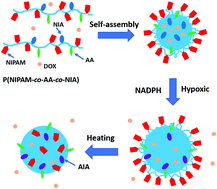Amphiphilic random copolymers poly(isopropylacryamide-co-acrylic acid-co-2-nitroimidazole acrylate) (P(NIPAM-co-AA-co-NIA)) with different contents of the 2-nitroimidazole (NI) group were facilely synthesized through RAFT and EDC reactions. These random copolymers self-assembled into spherical micelles at room temperature through the dialysis method. The NI groups exhibited stimulus responsiveness under hypoxia conditions. The hydrophobicity–hydrophilicity transformation could be realized through the change of NI groups into aminoimidazole (AI) groups. Moreover, the NIPAM segments endowed the copolymers with thermo-responsive properties. In addition, the content of the NI group in the copolymers would influence the hydrophilic–hydrophobic equilibrium of the copolymers, which in turn resulted in an obvious effect on the self-assembly behaviour of the copolymers and the morphologies of the self-assemblies. The micelles or vesicles can be used as the drug carriers to realize the controlled release of doxorubicin (DOX). The in vitro cell viability study of the DOX-loaded self-assemblies indicated that the cytotoxicities under hypoxic conditions were much higher than those under normoxic conditions. Moreover, the drug release behaviors also could be adjusted by changing the temperatures. Therefore, these random copolymers are expected to be multifunctional and smart carriers for the elimination of cancer cells.

